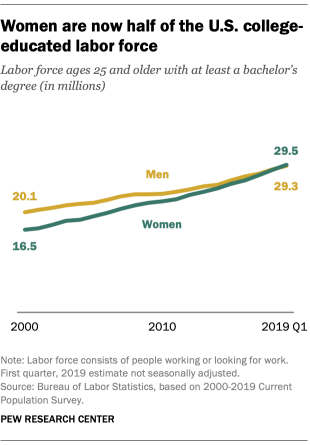
Note: For the latest data on women in the college-educated labor force, read our 2022 post.
Women are approaching a milestone in gender parity. 2019 will likely be the first year in which they are a majority of the college-educated labor force. As of the first quarter of 2019, 29.5 million women in the labor force had at least a bachelor’s degree, effectively matching the number of college-educated men in the workforce (29.3 million), according to a new Pew Research Center analysis of data from the U.S. Bureau of Labor Statistics.

This milestone matters for women because educational attainment is highly correlated with income. Women now comprise 50.2% of the college-educated labor force, up from 45.1% in 2000. They remain less than half (46.7%) of the overall workforce ages 25 and older.
While women have only recently reached parity with men in the college-educated workforce, they have been a majority of college-educated adults for more than a decade. Women first received more than half of the bachelor’s degrees awarded in the 1981-82 academic year; today they earn about 57% of bachelor’s degrees. The number of college-educated women in the adult population (ages 25 and older) surpassed the number of college-educated men in 2007.
Since there are more college-educated women than men, why has it taken more than 10 years for women to reach parity in the college-educated workforce? One important factor is that college-educated women are less likely than their male counterparts to be in the labor force. In 2018, 69.9% of college-educated women were in the labor force, compared with 78.1% of college-educated men. The number of women with at least a bachelor’s degree would have had to significantly outstrip the number of college-educated men to offset this labor force participation difference.
Though women are at parity with men in the overall college-educated labor force, they lag significantly behind in many specific occupations. For example, women account for only 25% of college-educated workers in computer occupations and 15% of college-educated workers in engineering occupations. In some other occupations, such as office and administrative support and health care practitioners and technicians, women represent the majority of college-educated workers.
Women’s growing representation among the college-educated labor force has important economic implications for individual workers and the economy. Census Bureau figures show that the typical worker (ages 25 and older) earned $41,900 in 2017, but a worker with at least a bachelor’s degree earned $61,300. (The earnings bump associated with a bachelor’s degree is larger for men than women. The median earnings of college-educated men is $74,900, compared with $50,200 for men overall. The typical college-educated woman earns $51,600, versus $36,000 for women overall.) About a third (35%) of U.S. adults 25 and older are college educated, but these individuals generate 57% of the economy’s earnings – $4.7 trillion out of $8.4 trillion total labor market earnings in 2017.
U.S. women may be far from parity in many facets of society – particularly in top positions in business and government – but they are making inroads in the upper echelon of the labor market. The growing number of college-educated women in the labor force translates into greater earning potential for women overall and could eventually contribute to the narrowing of the gender wage gap.
